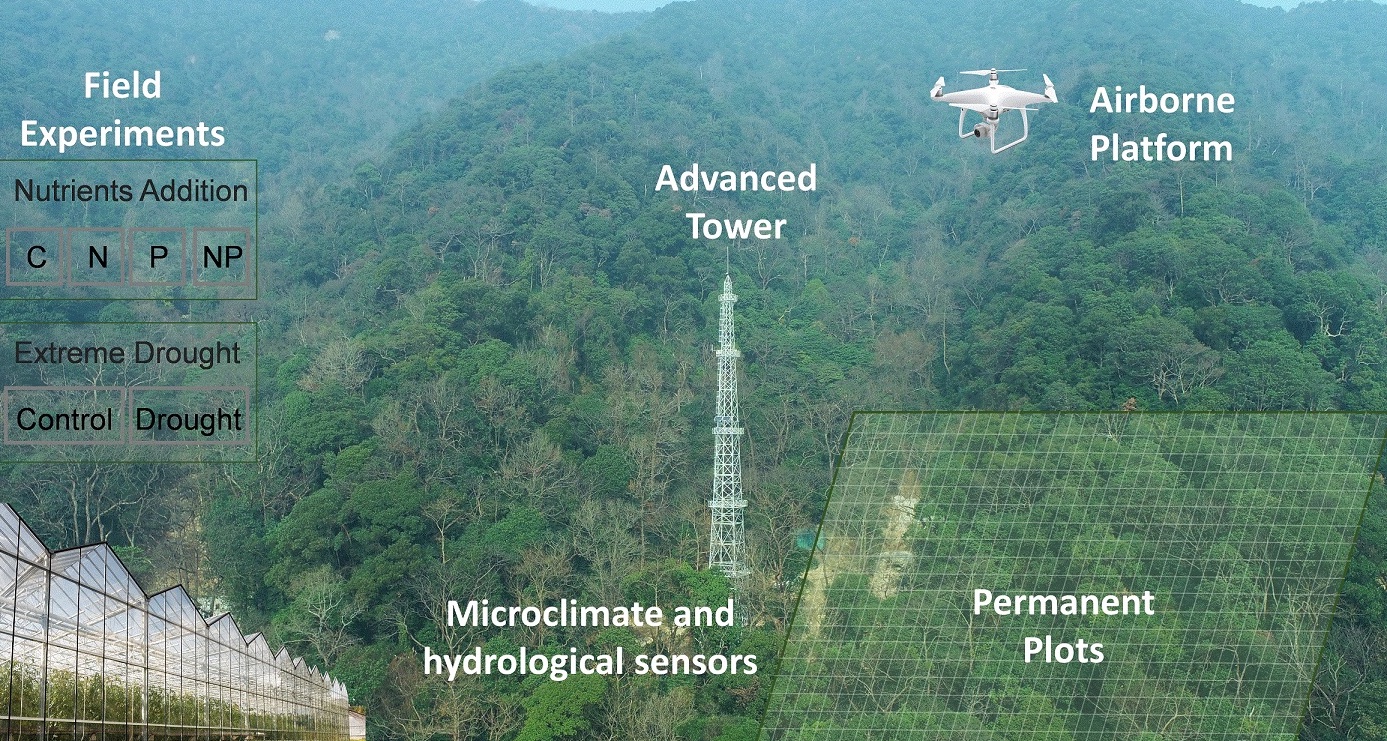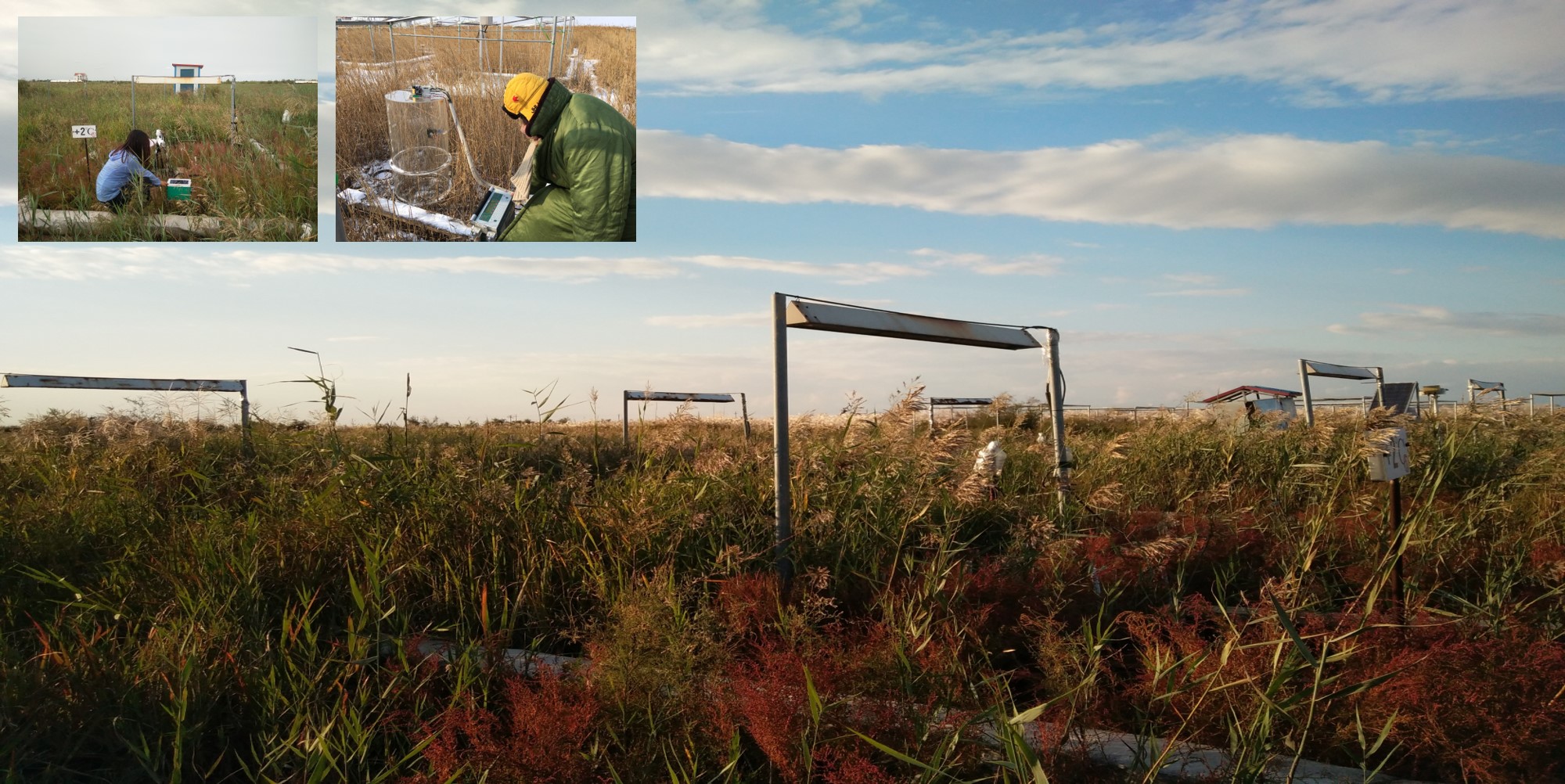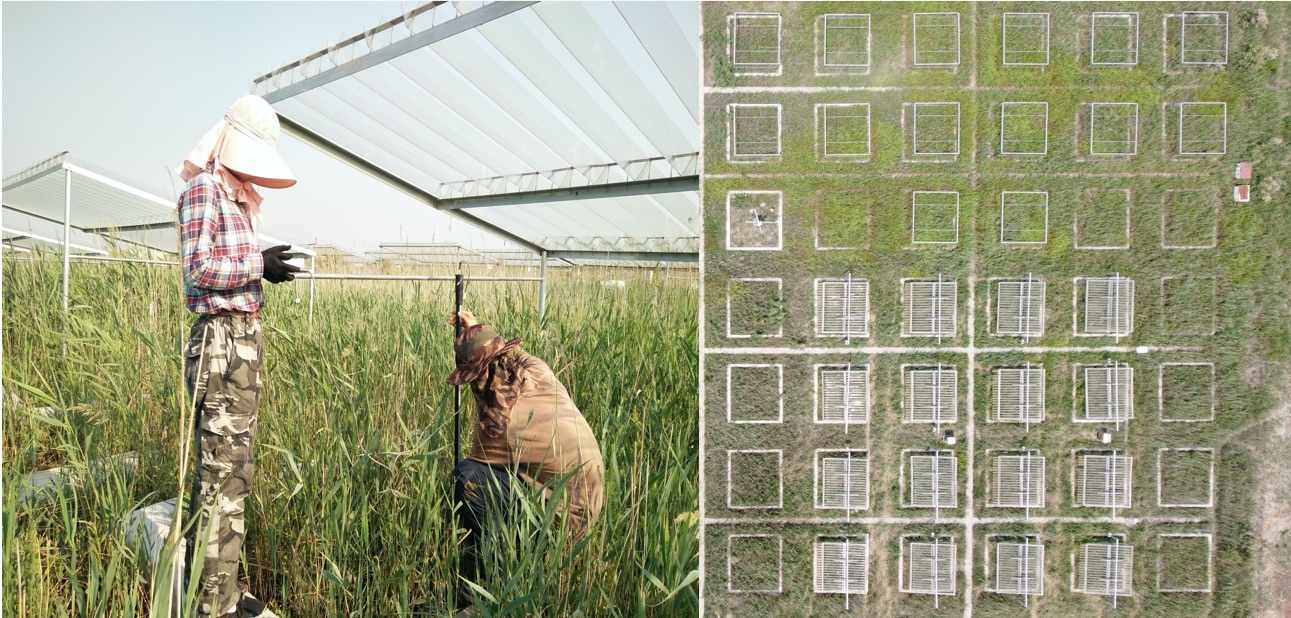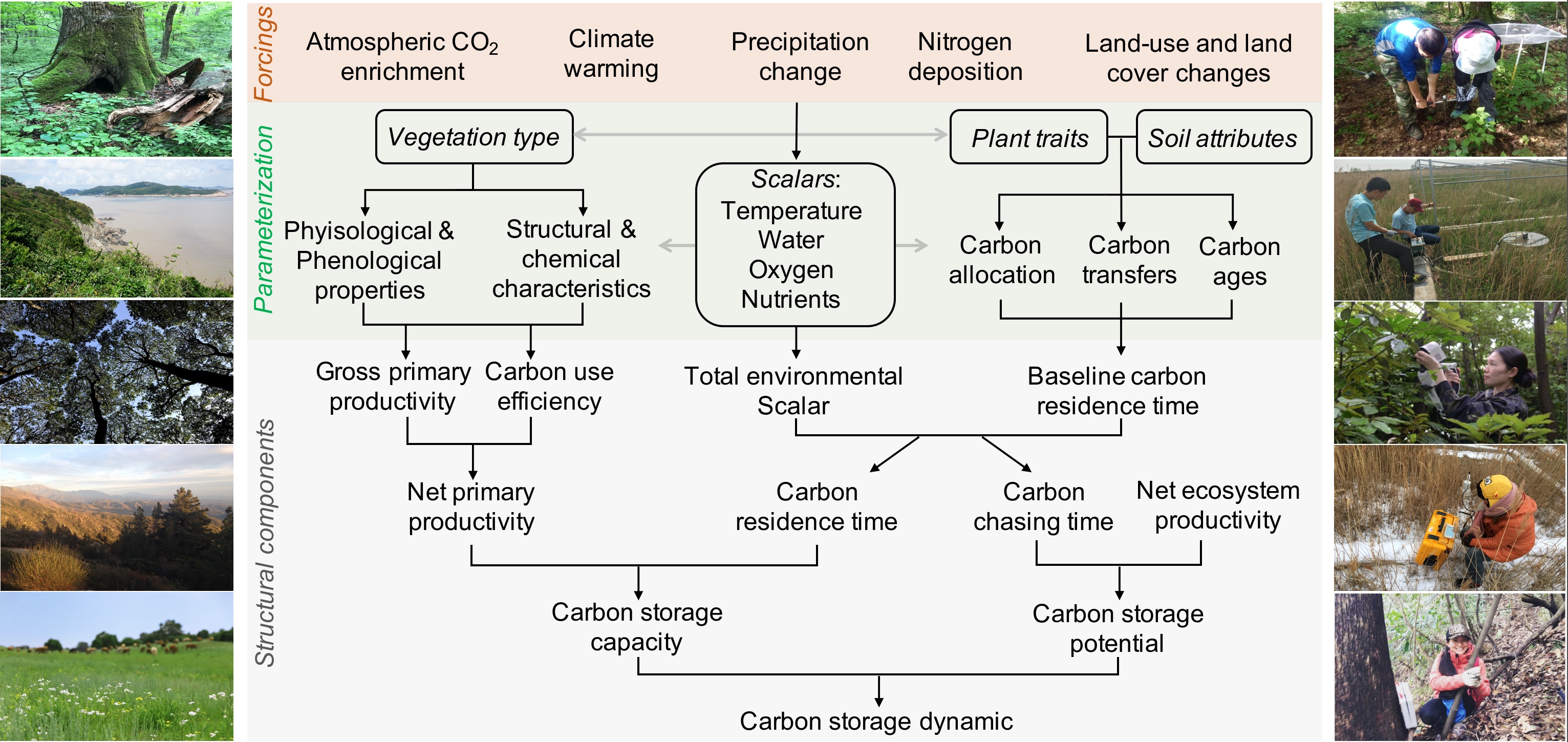The reasearch topics in our group are related to the two important natural ecosystems (broadleaf evergreen forest and coastal wetland) in the Eastern Asian Monsoon region. Multiple reserach tools are used to explore the interactions between vegetation structure and ecosystem functions under future environmental changes. Below are three current research topics in our group:

Location: The Titong Forest Ecosystem National Observation and Research Station (29°48′N, 121°47′E)
Key Questions
How vegetation structure regulates ecosystem fuctions and their resposnes to environmental changes?
Summary
The Tiantong National Forest Park locates in a subtropical climate in eastern China. The most dominant plant functiona type is evergreen broad-leaved forest, which is one major late-successional forest type in the subtropical area. This region has a subtropical monsoon climate, with mean annual temperature as 16.2 °C and mean annual precipitation as 1375 mm. The air temperature is lowest in January (4.2 °C) and highest in July (28.1 °C). The soil texture is primarily Ferralosol, with the pH ranging from 4.5 to 5.0. A 20-ha (500 × 400 m) permanent vegetation plot has been built on 2010 (one member site in the Forest Global Earth Observatory network; https://forestgeo.si.edu). The elevation of the Tiantong plot is 304.3 - 602.9 m. A eddy-flux tower has been built in the winter of 2020. Several field manipulative experiments have been conducted to explore the responses of this ecosystem to extreme drought and nutrient enrichment.
Publications
Qiao Y, Wang J, Liu H, Huang K, Yang Q, Lu R, Yan L, Wang X, Xia J. 2020. Depth-dependent soil C-N-P stoichiometry in a mature subtropical broadleaf forest. Geoderma 370, 114357
Xu X, Xia J, Zhou X, Yan L. 2020. Experimental evidence for weakened tree nutrient use and resorption efficiencies under severe drought in a subtropical monsoon forest. Journal of Plant Ecology 13, 649-656
Huang K, Xia J. 2019. High ecosystem stability of evergreen broadleaf forests under severe droughts. Global Change Biology, 25, 3494-3503.
Wang J, Yang Q, Qiao Y, Zhai D, Jiang L, Liang G, Sun X, Wei N, Wang X, Xia J. 2019. Relative contributions of biotic and abiotic factors to the spatial variation of litter stock in a mature subtropical forest. Journal of Plant Ecology, 12: 769-780
Gao Q, Bai E, Wang J, Zheng Z, Xia J, You W. 2018. Effects of litter manipulation on soil respiration under short-term nitrogen addition in a subtropical evergreen forest. Forest Ecology and Management 429: 77-83
Experiment 1: Wetland Elevated Temperature EXperiment (WETEX)

Location: The Yellow River Delta Ecological Research Station of Coastal Wetland (37°45′50″N, 118°59′24″E)
Experimental Duration: 2014.11 - now
Key Questions
How ecosystem carbon cycle respond to climate warming in the coastal wetland?
Summary
The mean annual temperature at this site is 12.9 °C, ranging from 26.7 °C in the summer to -2.8 °C in the winter. The average annual precipitation is 550–640 mm, nearly 70% of which falling between May and September. The groundwater table in this region is shallow with an average depth of 1.1 m. The periodic surface ponding is often observed following heavy rainfall events. Due to the flat terrain and high groundwater table, the entire area is covered mainly by wet and saline soil. The natural vegetation in this area consists of salt tolerant herbs, grasses, and shrubs. The most widespread vegetation types in the region are Phragmites australis, Suaeda glauca, Suaeda salsa, Tamarix chinensis, and Imperata cylindrical. The main growing season in this wetland ecosystem ranges from late April to late October.
A manipulative warming experiment was conducted in a costal wetland in the Yellow River Delta in November 2014. A complete random block design was used with one treatment (warming) and replicated four times for a total of 8 plots of 3×4 m2 (four control plots and four warming plots). The distance between any two adjacent plots was 3 m. All the warmed plots were heated continuously by infrared heaters (Kalglo Electronics, Bethlehem, PA, USA) suspended approximately 1.75 m above the ground from 1st November 2014. In each control plot, one ‘dummy’ heater with the same dimensions as the infrared heater was suspended at the same height to mimic the shading effects of the heater. All the heaters under the warming treatments were set at a radiation output of approximately 1600 W.
Publications
Sun B, Yan L, Jiang M, Li X, Han G, Xia J. 2020. Reduced magnitude and shifted seasonality of CO2 sink by experimental warming in a coastal wetland. Ecology (In Press)
Experiment 2: Seasonal Altered rainFall and Elevated Temperature experiment in Yellow river delta (SAFETY)

Location: The Yellow River Delta Ecological Research Station of Coastal Wetland (37°45′50″N, 118°59′24″E)
Experimental Duration: 2017.8 - now
Key Questions
How coastal wetlands in the Yellow river delta respond to the long-term winter-spring warming and summer-autumn drought?
Summary
This manipulative warming experiment was conducted since August 2017. A complete random block design was used with four treatments (control, summer-autumn drought, winter-spring warming, and their combination) and replicated four times for a total of 16 plots of 3×4 m2. The distance between any two adjacent plots was 3 m. All the warmed plots were heated continuously by infrared heaters suspended approximately 1.75 m above the ground. In each control plot, one ‘dummy’ heater with the same dimensions as the infrared heater was suspended at the same height to mimic the shading effects of the heater. All the heaters under the warming treatments were set at a radiation output of approximately 1600 W. The drought treament reduced the rainfll by about 50%.

Summary
The rapid expansion in modeling data size largely results from the increasing model complexity, which is characterized by adding more and more processes into the Earth system models (ESMs). However, there has been a large uncertainty on modeled global carbon cycle in ESMs. Uncertainties of modeling data collectively result from three sources, including external forcings, model structure, and process parameterizations. We are developing a traceability analysis to trace the model uncertainty back to its sources based a matrix approach. New data and experiments in ecosystem ecology are used to evaluate and improve the most uncertain components of global carbon-cycle models.
Publications
Zhou J, Xia J, Wei N, Liu Y, Bian C, Bai Y, Luo Y. 2021. A traceability analysis system for model evaluation on land carbon dynamics. Ecological Processes (In press)
Xia J, Wang J, Niu S. 2020. Research challenges and opportunities for using big data in global change biology. Global Change Biology, 26, 6040-6061.
Cui E, Huang K, Arain A, Fisher J, Huntzinger D, Ito A, Luo Y, Jain A, Mao J, Michalak A, Niu S, Parazoo N, Peng C, Peng S, Poulter B, Ricciuto D, Schaefer K, Schwalm C, Shi X, Tian H, Wang W, Wang J, Wei Y, Yan E, Yan L, Zeng N, Zhu Q, Xia J. 2019. Vegetation functional properties determine uncertainty of simulated ecosystem productivity: a traceability analysis in the East Asian monsoon region. Global Biogeochemical Cycles, 33, 668-689
Du Z, Weng E, Jiang L, Luo Y, Xia J, Zhou X. 2018. Carbon-nitrogen coupling under three schemes of model representation: a traceability analysis. Geoscientific Model Development, 11, 4399-4416
Xia J, McGuire AD, Lawrence D, Burke E, Chen G, Chen X, Delire C, Koven C, MacDougall A, Peng S, Rinke A, Saito K, Zhang W, Alkama R, Bohn TJ, Ciais P, Decharme B, Gouttevin I, Hajima T, Hayes DJ, Huang K, Ji D, Krinner G, Lettenmaier DP, Miller PA, Moore JC, Smith B, Sueyoshi T, Shi Z, Yan L, Liang J, Jiang L, Zhang Q, Luo Y. 2017. Terrestrial ecosystem model performance in simulating productivity and its vulnerability to climate change in the northern permafrost region. Journal of Geophysical Research: Biogeosciences 122: 430-446.
Rafique R, Xia J, Hararuk O, Asrar G, Leng G, Wang Y, Luo Y. 2016. Divergent predictions of carbon storage between two global land models: attribution of the causes through traceability analysis. Earth System Dynamics, 7, 649-658.
Jiang L, Yan Y, Hararuk O, Mikle N, Xia J, Shi Z, Tjiputra J, Wu T, Luo Y. 2015. Scale-dependent performance of CMIP5 Earth System Models in simulating terrestrial vegetation carbon. Journal of Climate doi: http://dx.doi.org/10.1175/JCLI-D-14-00270.1
Xia J, Niu S, Ciais P, Janssens I, Chen J, Ammann C, Blanken PD, Cescatti A, Bonal D, Buchmann N, Curtis PS, Chen S, Dong J, Flanagan LB, Frankenberg C, Georgiadis T, Gough CM, Hui D, Kiely G, Li J, Lund M, Magliulo V, Marcolla B, Merbold L, Montagnani L, Moors E, Olesen JE, Piao S, Raschi A, Roupsard O, Suyker A, Urbaniak M, Vaccari F, Varlagin A, Vesala T, Wilkinson M, Weng E, Wohlfahrt G, Yan L, Luo Y. 2015. Joint control of annual terrestrial carbon dioxide uptake by plant phenology and physiology. PNAS 112, 2788-2793.
Xia J, Luo Y, Wang Y-P, Hararuk O. 2013. Traceable components of modeled carbon storage capacity in terrestrial ecosystem. Global Change Biology, 19, 2104-2116.